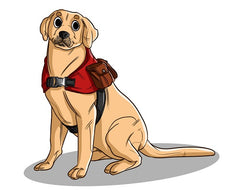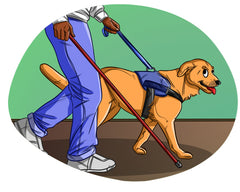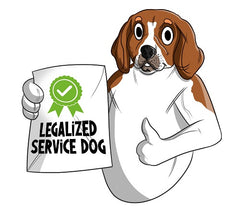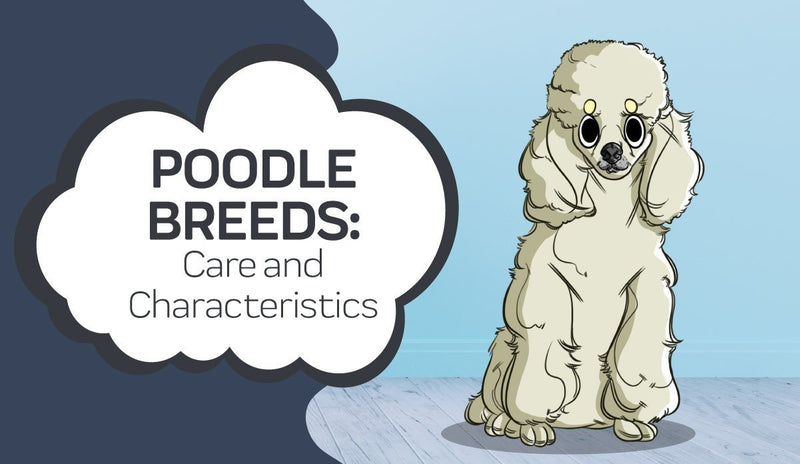 What Is A Service Dog?
What Is A Service Dog?
Service dogs are dogs that are trained to perform specific tasks for people with physical and mental disabilities and ailments. This includes mental health issues as well. While service dogs are every bit as cute and cuddly as any other dog, they have a specific job to perform and are not considered pets.
An example of a service dog that most of us are familiar with is guide dogs for the blind - also known as seeing-eye dogs. These dogs are trained to lead a blind person to where they want to go while also protecting them from hazards, like roads, steps, and other people.
Service dogs are different from other dogs with jobs (like police or cattle dogs) in that their job is to help a specific person with a disability, while other dogs simply fill in a job position. Dogs are the only kind of domesticated animal that can legally qualify as a service animal.
How Are Service Dogs Trained?
Training a service dog is a long and painstaking process, as they need to be able to perform their roles and remain professional at all times. Most service dogs are bred and sold to owners for the sole purpose of becoming service dogs. It is possible to train someone's pet to be a service dog, but only if they show an initial capacity for being highly trainable.
Some of the basic tasks that a service dog might do include:
- Answering the door for someone who can't check it themselves
- Bringing items to their owner
- Barks to alert their owner of danger, or to alert others that their owner is in danger
- Helping their owner maintain their balance
- Carries medication in a wearable pack for their owner
Most medium and large breed dogs can be service dogs, though Golden and Labrador retrievers are the most common service dog breeds.
Who Should Use A Service Dog?
 If you feel like you might be able to benefit from a service dog, speak to your doctor or therapist about the possibilities of owning one, what you would use a service dog for, and the problems you would try to solve by owning a service dog. Anyone who's life is seriously restricted or affected by a disability/mental illness could likely find a use for a service dog. Just remember that service dogs aren't a miracle cure and can't help with every condition.
If you feel like you might be able to benefit from a service dog, speak to your doctor or therapist about the possibilities of owning one, what you would use a service dog for, and the problems you would try to solve by owning a service dog. Anyone who's life is seriously restricted or affected by a disability/mental illness could likely find a use for a service dog. Just remember that service dogs aren't a miracle cure and can't help with every condition.
Anyone can technically own a service dog, but whether or not the dog is classified as a working service dog or is assigned to a person is another story. Simply owning a service dog doesn't necessarily make your dog a working service dog, and many service dog trainers won't work with individuals who don't meet certain qualifications. This is why it's important to speak with your therapist or doctor about your options.
How Service Dogs Can Help With Anxiety and Depression
While service dogs have traditionally performed tasks for physical disabilities, service dogs trained to help people with anxiety and depression are becoming more commonplace. One of the major issues that people with anxiety and/or depression face is self-imposed isolation.
Individuals with severe anxiety and depression isolate themselves for a variety of reasons, though most commonly it stems from a fear of the outside world, other people, and the stress those things can create.
Service dogs help break that isolation and fear in a variety of ways:
Unconditional love
 This gives people who might feel undeserving of love and attention a constant source of it and provides people who are too anxiety-ridden to seek out these things from other people. As anyone who's ever owned a dog knows, one of the best things about being a pet-parent is that dogs show their owners, unconditional love. Dogs don't judge their owners, place expectations on them, or have any requirements for showing affection.
This gives people who might feel undeserving of love and attention a constant source of it and provides people who are too anxiety-ridden to seek out these things from other people. As anyone who's ever owned a dog knows, one of the best things about being a pet-parent is that dogs show their owners, unconditional love. Dogs don't judge their owners, place expectations on them, or have any requirements for showing affection.
For people struggling with mental illnesses, simple things like changing clothes or getting out of bed can be a major ordeal. Having a service dog there during these daily routines can help people feel less alone and more confident.
New responsibilities
Another challenge that people with depression and/or anxiety face is keeping up with their daily chores, errands, and duties. People with these mental illnesses struggle with simple things like getting to work on time, keeping up their laundry, maintaining their finances, and so on.
A service dog adds to that list of chores - they need to be fed, walked, bathed, loved, and cared for. Unlike their laundry or checking their bank account, performing the chores of dog-ownership aren't optional. A dog has to be fed and walked, and since they provide an obvious and immediate reward for their owner, there is more motivation for the owner to perform these chores.
This can help those with anxiety and depression in two big ways. First, it gives them a sense of purpose and duty. Their dog needs them, and that means they have to keep themselves together for their dog. And second, it can help that individual with finding the motivation and discipline to start completing other chores on a routine basis.
Recognize panic attacks
Panic attacks are when a person with anxiety enters fight or flight mode over a circumstance that does not require that level of adrenaline or stress. For example, something as simple as ordering food might push an anxious person into a heightened state of stress.
On top of being scary, distressing, and embarrassing, panic attacks can be very hard to recognize for the people around the struggling individual. For everyone else, nothing has changed, but for the person having a panic attack, the world has entered a state of immediate turmoil.
Even though people might have a hard time recognizing panic attacks, that doesn't stop service dogs. Thanks to their heightened senses and training, they can detect panic attacks as soon as they start and begin working with their owner to minimize the effects of the attack - generally through soothing techniques.
Keep you grounded
And lastly, having a service dog around at all times can help an anxious or depressed person stay grounded in reality. Anxious and depressed people tend to live in their heads, worrying about what might be or dwelling on what already was. When left on their own, it can be hard to break out of these negative thought patterns.
Having a service dog with them can remind them to stay focused on the present. Whether that's through asking their owner for affection, needing to be fed, or simply spending time together, a service dog gives their owner fewer opportunities to stay stuck in their thoughts.
The Different Types Of Service Dogs
Guide Dogs
The service dog that most people are familiar with is the guide dog. Guide dogs help their owners navigate around obstacles, through buildings, and in other aspects of their day-to-day lives. Guide dogs are generally used by the visually impaired.
Alongside being the most familiar type of service dog, guide dogs are believed to be the oldest. There is evidence to support that people have been using guide dogs as far back as Roman times.
As a result, the majority of legislation surrounding service dogs was created with guide dogs in mind. This can make it a little tricky to find concrete legal answers in certain situations when it comes to other kinds of service dogs, though this is improving over time.
Hearing Dogs
Next up is hearing dogs, who perform a very similar role to guide dogs. Hearing dogs - as the name implies - help alert hearing-impaired owners to sounds they wouldn't otherwise hear.
This includes letting their owner know when the doorbell has been rung, when someone in another room is calling their name, or when there is some kind of alarm going off. Hearing dogs usually alert their owners by touching them and leading them to the source of the sound.
Hearing dogs are one of the few kinds of service dogs where size doesn't matter. So while labradors and golden retrievers are still the most common breeds used for hearing dogs, Chihuahuas, miniature poodles, and Shih Tzus are commonly used as well.
Mobility assistance dogs
Mobility assistance dogs help people aren't able to move around as easily as most people. This includes a fairly broad category of disabilities, both in type and severity. As a result, there are several different kinds of mobility assistance dogs, both in size and duties.
Typically, you'll see a mobility assistance dog perform tasks like pushing the buttons on automatic doors, bringing things to their owner and putting them back, and even acting as a brace for partially mobile owners.
Individuals with disabilities like arthritis, brain injuries, spinal injuries, and muscular dystrophy are the most common people to use mobility assistance dogs. The size and breed of the dog will depend on what level of assistance their owner needs and the kinds of tasks that the dog will be required to do.
Diabetic alert dogs
One of the most interesting kinds of service dogs are diabetic alert dogs. One of the biggest challenges that diabetics face is keeping up with changes in their blood sugar. Because these changes are imperceptible to humans - until it's already too late - people with diabetes have to carry devices for checking their blood sugar.
Dogs, however, do not have to rely on these devices to detect changes in a person's blood sugar. Thanks to their heightened senses, dogs can be trained to detect changes in blood sugar as they happen. When they notice their owner's blood sugar hit a dangerous limit, they alert their owner to check their blood sugar. This allows people with diabetes to check their blood sugar levels proactively, lowering the risk of the owner needing medical assistance.
Seizure alert & Response dogs
There are two types of service dogs trained to assist with epileptic individuals: Seizure alert dogs and seizure response dogs.
The role of seizure alert dogs is to perform some behavior that tells their owner and others that their owner is about to have a seizure. This allows their owner to move to a safe area, take seizure prevention/reduction medication, and to preemptively call for help.
You might be wondering, "How can a dog predict when someone is going to have a seizure?" That's an excellent question and one we don't seem to have the answer to, not yet at least. Seizure alert dogs are somewhat controversial for this reason. While many individuals with these dogs and seizure alert dog trainers claim that they can accurately predict seizures, there is no concrete evidence supporting this claim.
Seizure response dogs, on the other hand, are there to aid an epileptic person after a seizure starts and ends. They do this by letting others nearby know when their owner is having a seizure, moving their owner to a safer area if possible, and bringing their phone/medication to them once the seizure ends.
Psychiatric assistance dogs
Psychiatric assistance dogs are service dogs trained to help people who struggle with mental illness. This includes the different forms of PTSD, anxiety, and depression. Most psychiatric assistance dogs are trained to help individuals with PTSD, however, as it is the most severe condition of the three.
PTSD develops in a person after they experience a traumatic experience, like military combat, a car crash, natural disasters, working as a first responder, or being abused. One of the main challenges that PTSD survivors face is feeling safe in their daily lives. The trauma of their experiences can leave them feeling unsure of their surroundings and those around them.
Therefore, psychiatric assistance dogs assigned to PTSD victims serve as a point of reference for their owners - something they can trust and rely on. Psychiatric assistance dogs also perform tasks like entering buildings before their owner to see if it is safe, turning on the light via foot pedals, and acting as a physical barrier between their owner and others.
Autism support dogs
Autism support dogs are trained to aid people with autism in a variety of situations, particular children with autism. Autism, especially for younger kids, can be an isolating experience. It makes it hard to connect with others, to be accepted by others, and to express yourself to others.
Autism support dogs help with this in two ways. The first is by acting as a loyal companion for their ward. They break up the isolation that children with autism often experience, provide comfort during stressful situations, and act as an unconditional friend to their owner.
The second way autism support dogs help is by acting as an icebreaker for kids with autism. Autistic children can have a hard time bonding with their peers, but a support dog gives them something that just about everyone can bond over - a dog! Being able to have a dog with them everywhere they go can boost their confidence, help them feel soothed, and make it easier for them to befriend others.
Allergy detection dogs
Allergy detection dogs are trained to detect allergens in food before their owner eats it. These kinds of dogs are typically assigned to kids with food allergies who are still learning what is and isn't safe to eat. Their allergy detection dog can sniff out things like gluten and peanut butter in foods and alert them before they eat it.
 This is important, as young kids with allergies tend to have a hard time knowing what they can and can't eat. And many kids are simply too shy to communicate their needs to the cafeteria workers, not to mention that many cafeteria workers don't always know what's in their food and what isn't. An allergy detection dog can give their ward (and their parents) a greater sense of independence and confidence when deciding what to eat.
This is important, as young kids with allergies tend to have a hard time knowing what they can and can't eat. And many kids are simply too shy to communicate their needs to the cafeteria workers, not to mention that many cafeteria workers don't always know what's in their food and what isn't. An allergy detection dog can give their ward (and their parents) a greater sense of independence and confidence when deciding what to eat.
Or, better put, where aren't service dogs allowed. You've probably noticed signs on some of your favorite restaurants and shopping centers welcoming service dogs and their owners. Under the ADA, governments, businesses, and other organizations are required to allow service animals on their premises. This includes areas where pets generally aren't allowed, like a movie theater or dining area.
Where Are Service Dogs Allowed?
In other words, it's safe to assume that your service dog can go anywhere you can.
That said, there are some restrictions. First, it is the owner - not the service dog - that has a right to access these areas. This means that your service dog can go with you into these establishments, but it cannot go without you.
Also, service dogs are permitted to go everywhere you are permitted to go and are restricted from every area that you are restricted from. For example, when you go to a restaurant, you are allowed in the dining area, so your service dog must also be allowed in the dining area. However, since you can't go into the kitchen, your dog can't go in the kitchen either.
Service dogs can also be excluded from areas where they might pose a threat, fundamentally alter their environment, or place an undue burden on an establishment and/or its patrons.
Common examples include:
- Open-air zoos
- Sterile environments like hospitals or manufacturing factories
- Areas where food is prepared
- Federal courts
- Jails/Prisons
- Private homes
- Amusement park rides (though amusement parks themselves are usually fine)
- Churches
You also must have a certified and legal service dog in their service dog uniform to qualify for these privileges. Training your dog to perform service dog tasks without certification doesn't count, and bringing your service dog with you while they are in "pet-mode," (not actively performing service dog tasks) isn't allowed either.
Can People Ask About Your Service Dog?
A misconception that many people have is that businesses and individuals are not allowed to ask you about your service dog when you bring them into a building. If this were true, anyone could put a vest on a well-mannered dog and bring them everywhere, no questions asked. That might be fun as an owner, but for obvious reasons, it's not such a great idea.
This misconception is based on a real rule, which is that businesses and people can't ask you why you have a service dog. They can't ask about your disability, why you need the dog, why the dog is with you, and so on. However, they can ask you if your dog is a legal service dog and check for relevant proof (are they wearing a vest, are they trained, etc.), and ask what tasks your dog performs (i.e., acts as a guide, detects allergens, etc.). If these questions aren't answered appropriately, they are allowed to ask your dog to leave.
If you are considering bringing your dog into a building as a service dog without them being a true service dog, please consider otherwise. On top of being a federal crime, poorly trained dogs and rule-breakers make it harder for those with legitimate service dogs to be taken seriously.
How To Get A Service Dog
Before considering getting a service dog, it's important that you seriously consider your own needs and reasons for behind getting a service dog. Everyone loves pets, and having a highly-trained dog that can accompany you anywhere would be a dream come true for just about everyone. But wanting a service dog and needing a service dog is - unfortunately - not the same thing.
A service dog, like any other dog, comes with several responsibilities and duties that need to be fulfilled by the owner. Before starting the process of getting a service dog, make sure that you are both up to the task and in a position where owning a service dog would truly benefit you. If there are tasks that you aren't able to perform on your own or without great difficulty, then you are a good candidate for benefitting from a service dog.
All you need to qualify for service dog ownership is written documentation from your health professional explaining that you have and are seeking treatment for a physical disability or emotional/psychiatric disorder. Once you have that, you'll need to find a service dog provider that offers service dogs that can meet your specific needs. While training a service dog yourself is possible, it can take several years, and not all dogs are trainable enough to become service dogs.
What About Emotional Support Animals?
Emotional support animals are similar to service dogs in that they perform a support role for their owners, though it is much less rigid. Emotional support animals can be any domesticated animal, though the most common are dogs and cats.
The only role of an ESA is to provide their owner with emotional support. They don't need any special training, so you can register one of your existing pets as an ESA if you'd like. All you need for a pet to qualify as an ESA is a letter from a mental health professional stating that you have a mental health condition and that your ESA helps with it.
ESAs are a great alternative to service dogs for people with mental health issues that could benefit from the extra support of an ESA but don't necessarily need the extensive training or requirements that make a service dog. People with anxiety and/or depression usually do much better with an ESA than a service dog, especially since any pet can be an ESA.
Where Are Emotional Support Animals Allowed?
ESAs don't have all of the same privileges as service dogs, though they do have a few perks. For one, an ESA must be allowed to live in a home even if there's a no-pet policy. ESA owners also can't be charged additional pet fees by their landlord. You can bring an ESA on a flight free of charge as well, so long as they are considered a "small" ESA.
Other than that, however, ESAs are not allowed anywhere that pets are normally restricted from entering. This means that you cannot bring an ESA into a business or government building unless they give your ESA permission.
If You Need Support Right Now
If you've come across this article because you need emotional/mental health support right now, you can contact any of the following services 24/7/365:
- Emergency services: 911
- Suicide prevention: 1-800-273-8255 or live online chat
- Substance abuse and mental health: 1-877-726-4727
Sources:
What Services do Service Dogs Provide?Can a Service Dog Help with Your Anxiety?
HOW DO I GET A SERVICE ANIMAL?

















